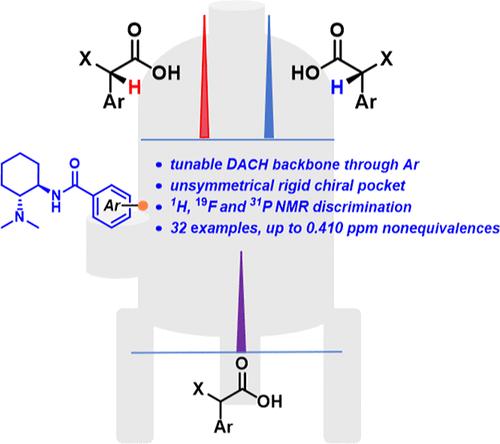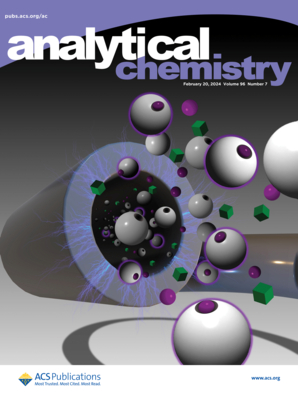DACH-Based Chiral Sensing Platforms as Tunable Benzamide-Chiral Solvating Agents for NMR Enantioselective Discrimination
IF 6.7
1区 化学
Q1 CHEMISTRY, ANALYTICAL
引用次数: 0
Abstract
Chiral discrimination is an indispensable tool that has pivotal importance in the assignment of absolute configuration and determination of enantiomeric excess in chiral compounds. A series of enantiomerically pure trans-1,2-diaminocyclohexane (trans-DACH)-derived benzamides were first synthesized by simple chemical steps, and 14 variated derivatives 6a–6n have been assessed as NMR chiral solvating agents (CSAs) for discrimination of the signals of mandelic acid (MA) in 1H NMR analysis. The highly efficient chiral recognition of CSA 6e on different substrates, including MAs, carboxylic acids, amino acid derivatives, and phosphoric acids (32 examples), was expanded via 1H, 19F, and 31P NMR spectroscopy. The quality of enantiodiscrimination was evaluated by means of the enantioresolution parameter Rs. Single-crystal X-ray analysis of three derivatives 6c, 6e, and 6h helped to understand enantiomeric recognition for the promising NMR analysis. Interestingly, the NMR signals of nonequivalent protons between the R and S configurations were completely opposite in the presence of CSA 6e and its stereoisomer, which can be utilized to establish a straightforward method for the configuration assignment of diverse hydroxy acid substrates.

基于 DACH 的手性传感平台作为可调苯甲酰胺-手性溶解剂用于 NMR 对映选择性鉴别
本文章由计算机程序翻译,如有差异,请以英文原文为准。
求助全文
约1分钟内获得全文
求助全文
来源期刊

Analytical Chemistry
化学-分析化学
CiteScore
12.10
自引率
12.20%
发文量
1949
审稿时长
1.4 months
期刊介绍:
Analytical Chemistry, a peer-reviewed research journal, focuses on disseminating new and original knowledge across all branches of analytical chemistry. Fundamental articles may explore general principles of chemical measurement science and need not directly address existing or potential analytical methodology. They can be entirely theoretical or report experimental results. Contributions may cover various phases of analytical operations, including sampling, bioanalysis, electrochemistry, mass spectrometry, microscale and nanoscale systems, environmental analysis, separations, spectroscopy, chemical reactions and selectivity, instrumentation, imaging, surface analysis, and data processing. Papers discussing known analytical methods should present a significant, original application of the method, a notable improvement, or results on an important analyte.
 求助内容:
求助内容: 应助结果提醒方式:
应助结果提醒方式:


